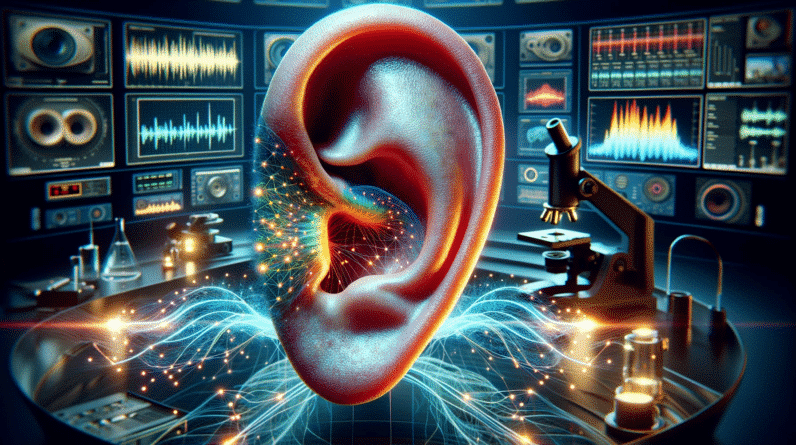
We may earn money or products from the companies mentioned in this post.
As an Amazon Associate I earn from qualifying purchases.
Introduction
Have you ever heard a buzzing or ringing sound in your ears that only you seem to notice? If the answer is yes, you may have been experiencing a symptom of tinnitus. Tinnitus can be quite bothersome and can negatively impact everyday life. That’s why understanding its various forms and nuances, including different kinds of tinnitus and their implications, is vital. In this article, we’ll dive into the exciting world of tinnitus and explore its labyrinthine complexity. Ready to set sail? Let’s embark!
What is Tinnitus?
Tinnitus can be quite a mystery for those who hear the unsettling sounds but don’t understand their origin. In its essence, tinnitus is the perception of noise or ringing in your ears, and it’s a relatively common problem. The American Tinnitus Association estimates that over 50 million Americans, about 15% of the one’s population, experience some form of tinnitus. However, tinnitus isn’t a condition itself; it’s a symptom of an underlying condition, such as age-related hearing loss, ear injury, or a circulatory system disorder. Dive deeper into the world of tinnitus here to get a glimpse of how it can affect individual lives dramatically.
The Two Types of Tinnitus Identified Are
Tinnitus is prevalent, and yet many people fail to realize that it comes in more than one form. Two of the most common types are subjective tinnitus and objective tinnitus, each with its unique characteristics and triggers.
Subjective tinnitus is the most common type and is caused by ear problems in your outer, middle, or inner ear. It can occur in both ears or just one and is often associated with some degree of hearing loss, making it a highly individual experience. Want to know more about the intricate world of these tinnitus types? Exploring further here might bring forth interesting revelations.
Sensory Tinnitus
Falling under the umbrella of subjective tinnitus is sensory tinnitus. It’s a form of tinnitus that has strong connections to how your brain processes sounds. With sensory tinnitus, your brain may interpret electrical signals as noise, creating persistent sounds that only you can perceive. This type is often linked to noise-induced hearing loss and is a clear testament to how our bodies can react to our surroundings in ways we cannot always control. To delve further into the mechanics of sensory tinnitus and its impact on daily life, check out this informative link.
Impacted by sensory tinnitus or want to learn more about this unique variant? An excellent starting point for understanding and managing sensory tinnitus can be valuable resources like the loved ones at [The American Tinnitus Association] and [National Institute on Deafness and Other Communication Disorders (NIDCD)].
Are There Different Types of Tinnitus?
Indeed, despite the widespread nature of tinnitus, it’s not monolithic. There are actually several different types that can be experienced, each carrying its unique set of characteristics and triggers. They include pulsatile tinnitus, where one hears rhythmic noises that often beat in time with the pulse, and musical tinnitus, a rarer form in which individuals hear music or singing, sometimes the same tune on a loop. Another one is low-frequency tinnitus, which is also unique because the sounds individuals hear are similar to those coming from the environment, such as a humming refrigerator. Isn’t it fascinating how varied our sensory perceptions can be? More knowledge on this here.
Kinds of Tinnitus
In addition to different types, did you know there are also a variety of kinds or categories of tinnitus that people experience? Let’s delve into this in a bit more detail. There are three levels of tinnitus severity: slight, moderate, and severe. Each category can have significantly different impacts on an individual’s life. Slight tinnitus might only present problems in quiet environments, while severe tinnitus may be so intrusive it affects an individual’s daily life. To give it structure, tinnitus can be characterized as being acute (short term) or chronic (long term), intermittent (comes and goes) or constant, and mild or severe. Our understanding of tinnitus unfolds in even more detail here.
Understanding Tinnitus Sounds
The vast variety of tinnitus even extends to the kind of sounds people hear. Many describe it as a ringing or buzzing sound, but it could also manifest as hissing, humming, clicking, or even roaring. Some people also hear what sounds like music or singing—a phenomenon known as musical tinnitus. The sound might be in one ear or both, constant or occasional, and vary in pitch. Now comes the tricky part: sometimes, the perceived sound is so low-frequency that it blends with normal environmental sounds, which can make it even more challenging to diagnose. Whew! That’s quite a lot of sounds, isn’t it? Deepen your understanding of this world of tinnitus sounds.
Individuals seeking an expert opinion on the different kinds of tinnitus and accompanying sounds could also consider turning to the [British Tinnitus Association] for comprehensive resources and support.
Forms of Tinnitus and Their Impact on Health
To add more to our comprehension of tinnitus, we need to grasp that there are principally two forms of it: acute and chronic. Acute tinnitus is a short-term form that lasts for up to three months, while chronic tinnitus is long-term and persistent, lasting for more than three months.
The effect of tinnitus on one’s health can cover a broad spectrum – from minimal annoyance to severe interference with daily life. People with tinnitus often experience fatigue, stress, sleep problems, and an overall lowered quality of life. It’s not uncommon for someone with severe tinnitus to also have depression, anxiety, or other psychological distress.
Moreover, tinnitus could also impact one’s cognitive functioning, with some studies suggesting a correlation with reduced cognitive performance. Indeed, this mere symptom could ripple into impacts far more expansive than imagined. For a more detailed delve into the world of these forms and their health impacts, follow this informational journey here.
Conclusion
The world of tinnitus is as intricate as it is intriguing. We’ve delved into understanding tinnitus, the two common types, and even how it can come in different kinds and manifest in various sounds. Along with acknowledging the existence of various forms of this condition, one must also understand its impact on health. We hope this guide has equipped you with a deeper understanding of tinnitus and its labyrinthine intricacies.
Yet, our exploration doesn’t stop here. Tinnitus is a wide arena with many aspects still to be explored for a comprehensive understanding. Each variant and type carry unique traits and characteristics beckoning deeper understanding. Let’s continue this exploration and learn more about this fascinating condition, why it happens, and how it can be managed. For more in-depth knowledge and insights, we cordially invite you to our website, a treasure trove of vast information on tinnitus.
Lastly, remember, when it comes to health, knowledge is indeed power. So let’s continue learning as we navigate the pathways of better health and wellbeing together. The exploration continues. Are you ready for the journey?
Kinds Of Tinnitus - Frequently Asked Questions (FAQ)
Tinnitus varies significantly among individuals, thus creating different kinds. The types generally range from subjective tinnitus (most common, where only the patient can hear the noise), to objective tinnitus (the noise/ringing can be heard by others). Additionally, it includes pulsatile tinnitus (rhythmic noise that often keeps pace with the heartbeat), and musical tinnitus (hearing music or singing).
Yes, the sound perceived can vary widely for different types of tinnitus. For some, it may manifest as a low hum, while for others, it may be a high-pitched buzz. Some people even hear what sounds like music or singing—a phenomenon known as musical tinnitus. The sound might come and go or remain constant, and its volume can fluctuate.
Tinnitus can significantly impact individuals, leading to sleep problems, stress, and fatigue. Severe tinnitus can also interfere with concentration and cause psychological distress, such as depression or anxiety. A correlation has also been suggested between tinnitus and reduced cognitive performance.
While there is currently no cure for tinnitus, there are several methods to help manage the condition. Treatments include sound therapy, cognitive behavioral therapy, tinnitus retraining therapy, and medication in some cases. Health professionals can recommend the best approach based on individual symptoms and needs.
Amazon and the Amazon logo are trademarks of Amazon.com, Inc, or its affiliates.






15 Comments